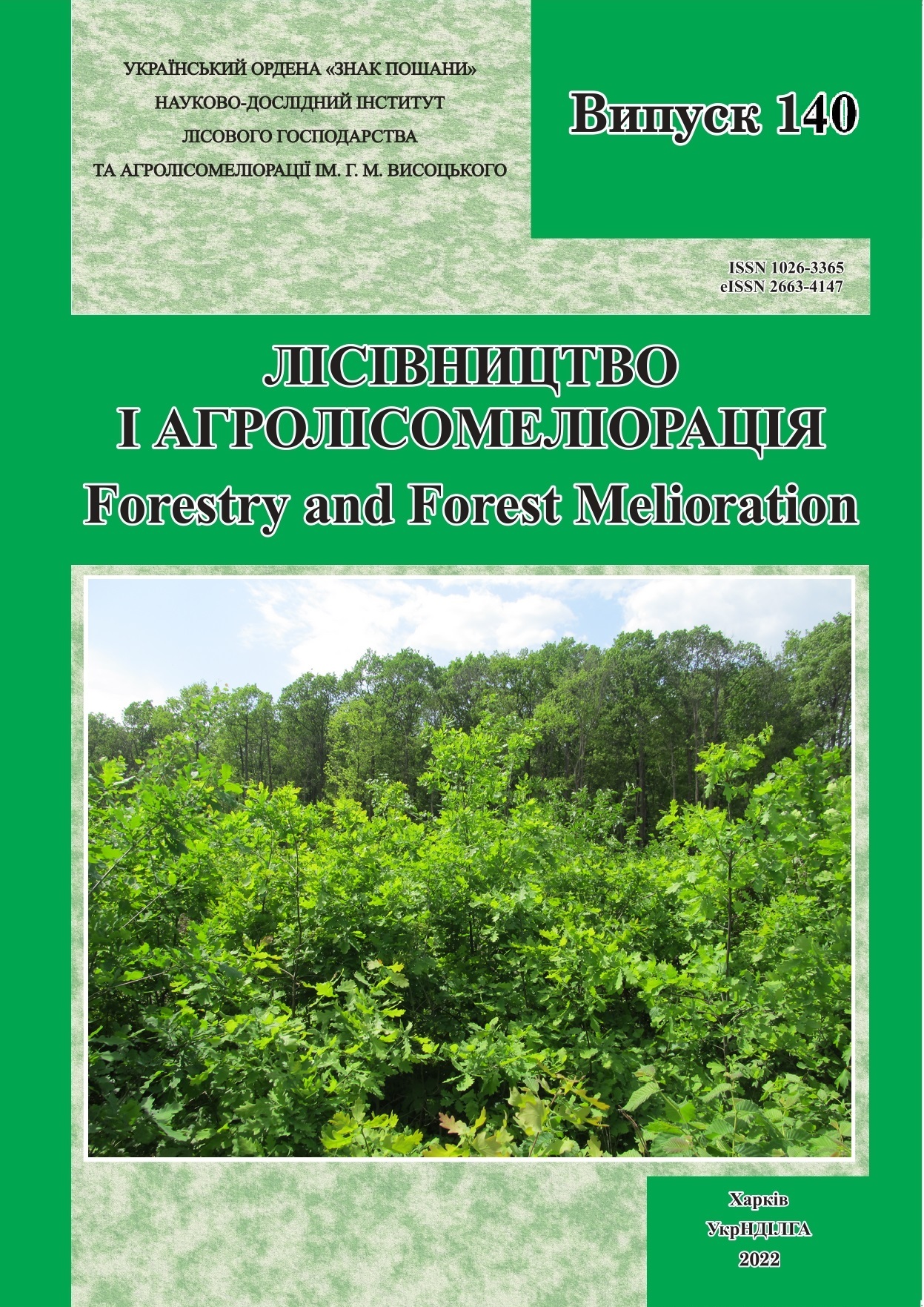Анотація
Проаналізовано базу даних ВО «Укрдержліспроект» станом на 2017 р. стосовно лісового фонду Донецького, Харківського та Сумського ОУЛМГ для визначення розподілу за типами лісорослинних умов (ТЛУ) площі вкритих лісовою рослинністю ділянок, площі насаджень із Ulmus sp. як головної породи та площі виділів із наявністю Ulmus sp. у складі насаджень. У лісовому фонді Донецького, Харківського та Сумського ОУЛМГ визначено 16, 17 і 16 ТЛУ, з Ulmus sp. у складі – 14, 13 і 11 ТЛУ, а з Ulmus sp. як головною лісоутворювальною породою – 11, 9 та 8 ТЛУ відповідно. U. minor є найбільш поширеним, U. glabra – найменш. U. pumila домінує в фонді Донецького ОУЛМГ та відсутній у Сумському ОУЛМГ. U. laevis найбільш поширений у Харківському ОУЛМГ. U. minor частіше трапляється у свіжих і сухих грудах, U. laevis у Донецькому ОУЛМГ – у сухих і свіжих грудах, у Харківському – у свіжих грудах, у Сумському – у свіжих суборах, сугрудах і грудах. U. pumila у Донецькому ОУЛМГ надає перевагу сухим сугрудам, у Харківському – свіжим грудам, у Сумському – свіжим суборам, свіжим сугрудам та вологим сугрудам. U. glabra надає перевагу вологим сугрудам а у Харківському ОУЛМГ – також свіжим грудам.
Посилання
Atramentova, L. A. and Utevskaya, O. M. 2008. Statistical methods in biology. Gorlovka, Likhtar, 248 p. (in Russian).
Brasier, C. M. 1991. Ophiostoma novo-ulmi sp. nov., causative agent of the current Dutch elm disease pandemics. Mycopathologia, 115:151–161. https://doi.org/10.1007/BF00462219
Brown, N., Vanguelova, E., Parnell, S., Broadmeadow, S., Denman, S. 2018. Predisposition of forests to biotic disturbance: Predicting the distribution of Acute Oak Decline using environmental factors. Forest Ecology and Management, 407: 145–154. https://doi.org/10.1016/j.foreco.2017.10.054
Collin, E. and Bozzano, M. 2015. Implementing the dynamic conservation of elm genetic resources in Europe: case studies and perspectives. iForest – Biogeosciences and Forestry, 8(2): 143–148. https://doi.org/10.3832/ifor1206-008
Davydenko, K. V., Borysova, V., Shcherbak, O., Kryshtop, Y., Meshkova, V. 2019. Situation and perspectives of European ash (Fraxinus spp.) in Ukraine: Focus on eastern border. Baltic forestry, 25(2): 193–202.
Diekmann, M. 1996. Ecological behaviour of deciduous hardwood trees in Boreo-nemoral Sweden in relation to light and soil conditions. Forest Ecology and Management, 86: 1–14. https://doi.org/10.1016/S0378-1127(96)03795-4
Enderle, R., Stenlid, J., Vasaitis, R. 2019. An overview of ash (Fraxinus spp.) and the ash dieback disease in Europe. CAB Rev, 14: 1–12. https://doi.org/10.1079/PAVSNNR201914025
Gagen, M., Matthews, N., Denman, S., Bridge, M., Peace, A., Pike, R., Young, G. 2019. The tree ring growth histories of UK native oaks as a tool for investigating Chronic Oak Decline: An example from the Forest of Dean. Dendrochronologia, 55: 50–59. https://doi.org/10.1016/j.dendro.2019.03.001
General characteristics of Ukrainian forests. 2022. [Electronic resource]. State Forest resources Agency of Ukraine. Available at: https://forest.gov.ua/en/areas-activity/forests-ukraine/general-characteristic-ukrainian-forests (accessed 15.03.2022).
Gensiruk, S. A. 1992. Forests of Ukraine. Kyiv, Naukoa dumka, 408 p. (in Ukrainian)
J?risoo, L., Adamson, K., Padari, A., Drenkhan, R. 2019. Health of elms and Dutch elm disease in Estonia. European Journal of Plant Pathology, 154 (3): 823?841. https://doi.org/10.1007/s10658-019-01707-0
Maslovata, S. A., Mamchur, T. V., Parubok, M. I. 2016. A collection of herbarium specimens of the genus Ulmus L. in the scientific herbarium of the Uman National University of Horticulture. Proc. of conf. Prospects of forestry and horticulture: Third Annenkiv readings (May 12, 2016, Uman, UNUS). Uman, p. 152–157 (in Ukrainian).
Matuszkiewicz, J. M. 2015. Rola wi?z?w w zespo?ach ro?linnych Polski. In: Buga?a, W., Boraty?ski, A., & Iszku?o, G. (Eds.). Wi?zy. Bogucki Wydawnictwo Naukowe, Pozna?, Poland, p. 181–223.
Menkis, A., ?stbrant, I. L., W?gstr?m, K., Vasaitis, R. 2016. Dutch elm disease on the island of Gotland: monitoring disease vector and combat measures. Scandinavian Journal of Forest Research, 31: 237–241. https://doi.org/10.1080/02827581.2015.1076888
Migunova, Ye. S., 1993. Forests and forest lands (Quantitative evaluation of interactions). Moscow, Ecology, 364 p. (in Russian).
Napiera?a-Filipiak, A., Filipiak, M., ?akomy, P., Ku?mi?ski, R., Guba?ski, J. 2016. Changes in elm (Ulmus) populations of mid-western Poland during the past 35 years. Dendrobiology, 76: 145–156. http://dx.doi.org/10.12657/denbio.076.014
Puzrina, N. V. and Yavny, M. I. 2020. Elm stands of the Kyiv Polissia of Ukraine: silvicultural and health condition: monograph. Kyiv, NUBiP of Ukraine, 177 p. (in Ukrainian).
Santini, A. and Faccoli, M. 2015. Dutch elm disease and elm bark beetles: a century of association. iForest – Biogeosciences and Forestry, 8: 126–134. https://doi.org/10.3832/ifor1231-008.
Skolskyi, I. M. 2013. Physical properties of Ulmus glabra wood in the conditions of the Western Forest Steppe of Ukraine. Scientific bulletin of UNFU, 23.15: 33–40 (in Ukrainian).
Thomas, P. A., Stone, D., La Porta, N. 2018. Biological flora of the British Isles: Ulmus glabra. Journal of Ecology, 106(4): 1724–1766. https://doi.org/10.1111/1365-2745.12994
Yavny, M. I. and Puzrina, N. V. 2018. Bacterial disease of Ulmus glabra Huds. in the stands of the Kyiv Polissia of Ukraine. Microbiological Journal, 80 (1): 67–76 (in Ukrainian). https://doi.org/10.15407/microbiolj80.01.067
Zakharchuk, O. I. 2014. Ulmus L.: distribution in the forest fund of Ukraine, condition and problems of its preservation. [Electronic resource]. Scientiic Reports of NULES of Ukraine, 2(44). Availale at: http://nd.nubip.edu.ua/2014_2/14.pdf (accessed 15.03.2022) (in Ukrainian).
Zhigalova, S. L. 2016. Families Ulmaceae Mirb. and Celtidaceae Endl. in the flora of Ukraine. Introduction of plants, 4: 52–58(in Ukrainian). https://doi.org/10.5281/zenodo.2457713

Ця робота ліцензується відповідно до Creative Commons Attribution 4.0 International License.
